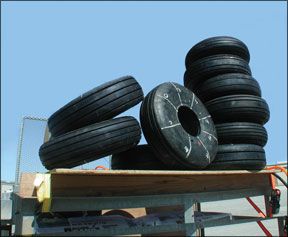While car tires are all about the finer points of traction and resistance to hydroplaning, the best we can hope for with airplane tires is that theyll make it through a couple of annuals. To do that, they need a lot of tread depth, the right rubber compound and a pilot whose idea of making the first turnoff doesnt involve landing with the brakes locked. Heat is hard on tires, but landings chew up the rubber so to find out which tire is top dog, we conducted the second Great Florida Tire Death Match, subjecting each of 11 new tires to 300 blistering, rubber-burning simulated touchdowns on a flat stretch of I-75. Conclusion? He with the most tread wins, and that would be the Goodyear Flight Custom III. In this case, “wins” means delivers the most landings for the money-in other words, the best value. But that doesnt mean the most expensive tire is always the best choice for every owner. More on that later, but first, on to the tests.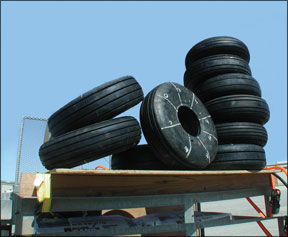
If most of your flying is from A to B, you probably don’t do many landings, even if each “landing” might be labeled a series of controlled collisions. For many owners, tire replacement is more about age- weather-related cracking, for example-than it is tread wear. Still, smearing rubber on the runway is what its all about so we dug out our test rig, mounted it on the trailer, bought a sample of most 6.00 X 6 new tires and tubes and got busy.
As shown here, the rig consists of a pneumatically operated pivoting arm mounted on a utility trailer towed by a pickup truck. The arm is activated by a valve-call it an air-powered gear selector-that reasonably simulates a retractable gear airplane by allowing a tire touchdown and retraction about every six seconds.
When we conducted these tests four years ago, we simulated 200 landings, but this time we upped the ante to 300, albeit with a slightly lighter weight load on the trailer. We also skipped the skid destruction test, which involved a mounted wheel and tire touched down at 30 MPH on a closed runway. We wanted to know how the tires dealt with this abuse. Some did, some didnt.
Of the 11 tires tested in 2004, we rated six as unserviceable after the skid test. There wasnt much to gain from repeating it this year, so for our 2008 edition, we substituted a two-mile taxi test at 30 MPH to test heat buildup. We measured the tires temperature before and after the taxi test and from there, we went right into the simulated landings. We also simulated a faster landing, at between 65 and 70 MPH, instead of 55 MPH or so in 2004. We chose this speed to better approximate
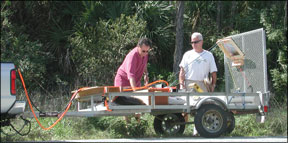
the 60-knot touchdown many tires see in actual use.
We weighed and measured each tire before and after the tests. In addition to tread depth, we measured diameter, finding that most tires are less than 1/8-inch out-of-round. As one might expect, the less expensive tires displayed the greatest variation; premium tires from their respective manufacturers exhibited better quality control with regard to roundness. Goodyears Flight Custom, for example, was spot on for roundness, as was the Michelin Aviator. The inexpensive Specialty Aero Trainer, Condor and Super Hawk were at least 1/16-inch out of round.
Weight varied, too, with the less expensive tires generally being the lightest, given that their construction uses less steel, fabric and/or rubber. Goodyears top-rated Flight Custom III was the heaviest tire, at 11 pounds, 4 ounces, followed by Dessers massive Monster retread at 11 pounds. The lightweight was Specialtys Aero Trainer at 6 pounds, 13 ounces.
Rubber hardness can be a predictor of tire durability, although in the end, we think tread depth trumps all. We measured hardness with an analog durometer at five points along each tiress tread. Interestingly, we found that hardness often varied from point to point along the treads circumference and from shoulder to shoulder. Again, you get what you pay for. The cheaper tires seemed to vary in hardness while the premium products were more consistent.
Prior to hitting the road, we marked each tires sidewall into eight segments and using a digital depth gauge, we measured groove depth at each segment mark at the beginning and end of each test. Although the tires vary in number of grooves, to make things simple, we used only wear data from the two center grooves, averaging the 16 values for an overall wear indication. No surprise that the data
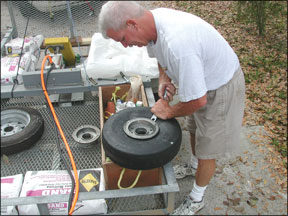
showed the centers of the tires wore more than the outer grooves.
Hot Stuff
As noted in our previous report, heat is hard on tires and we were surprised how much variability in heat rise we recorded during the two-mile taxi test. While the Goodyear Flight Custom III ran the coolest, some of the least expensive tires were right behind it, such as the Condor and the Super Hawk. Dessers Monster and the Specialty Air Hawk ran the hottest, as shown in the chart at left.
We also recorded before and after temperature rise during the 300-landing cycle test. Here, the cheaper tires acquitted themselves well, with the bargain $45.95 Aero Trainer tire showing a scant 2.3-degree rise. The Desser Monster and the premium Michelin Air topped the scale in landing cycle heat rise, which while not a predictor of imminent failure, is also not desirable, in our view.
To keep our observations consistent, we had to park in the shade to prevent direct sunlight on the tire from contaminating the data. For what its worth, even in Floridas weak February sun, solar heat rise was so significant that we think tire covers might be worth the investment to reduce heat and UV damage. As described in the sidebar at right, our long-term weathering test showed that UV and heat really trash tires, turning the soft rubber brittle and badly oxidizing the surfaces.
As we learned in our previous tests, if a tire is landed frequently, durability is a function of tread depth and wear rate. Deeper tread is a strong plus, but if the rubber wears rapidly, the tire might not last as long as one with shallower tread but a lower wear rate. The additional variable is price and this has the largest impact
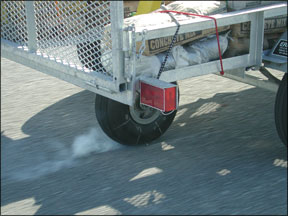
on value. From most to least, the tread depth ratio in these new tires was 1.6 to 1, but the most-to-least cost ratio was more than 3 to 1.
To make some sense of cost versus tread versus wear rate, we constructed a simple formula. First, we established a wear rate for each tire-in other words, how much comparative wear each tire showed per 300 landing cycles related to its total tread depth.
We used this to roughly calculate how many cycles the tire would theoretically deliver and we divided this number into the discount price to determine a value ranking. The number itself is arbitrary; the ranking is useful. Our intent was to answer several questions: Which is the best tire for minimum wear? Which is best value tire? Are cheap tires a better buy under any circumstances? First, overall wear, irrespective of tread depth and cost. The top three here are Goodyears Flight Special, the Michelin Aviator and the bargain Super Hawk, all of which had more than 95 percent of their tread remaining after the test. Although this sounds good, heres the problem: Each of these tires started out with 20 percent less tread depth than the top rated Goodyear Flight Custom and more than 30 percent less than Dessers Monster.
When total tread depth is considered against wear rate and cost, a different picture emerges. At the premium end of the market-tires in the $100 and up range-the Goodyear Flight Custom III tops the value equation because its .270 inch tread depth exceeds its competition-mainly its stablemate Flight Special and the Michelin products-and the price differences arent that great between these tires. While its true that the Flight Custom had a slightly higher wear rate, it wasnt enough to offset that generous tread depth.At the lower end of the market-tires under $100-the wear rate grouping and price relationships were scattered enough that the Specialty Air Hawk came out as a winner largely because of an edge in total tread depth. Cheaper tires such as the Condor, the Specialty Aero Trainer and Air Trac didnt do as we’ll because-you can see it coming-they started with less tread or they had a higher wear rate.
If there was a surprise for this round of testing, it was the Monster retread. In our last test, we picked it as the top value using a slightly different formula. But this time, its combination of a slightly higher wear rate against the other tires and a higher price dropped it from the top ranking.
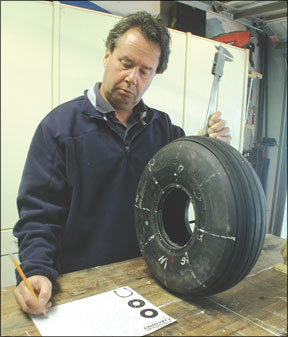
This could have been related to more test cycles or the fact that the simulated weight on the tire was lower. Also, the Monsters rubber was among the softest tested. Nonetheless, we still like the Monster as a good buy because of its top ranked tread depth-good protection against skids and lockups.
One caveat: Drawing take-it-to-bank conclusions from what are actually very slim differences in actual tire wear rates is problematical. But were comfortable making some general recommendations.
Goodyears Flight Custom III came out at the top of our cost vs. observed tread wear equation for two simple reasons: The tire simply starts with a deeper tread than most of its competition and the wear rate is comparable. The only tire with more tread, Dessers Monster retread, also features a slightly softer rubber compound-yielding a durometer value of 61, vs. the Goodyears 63. Plus, the Flight Custom has only two grooves, so it puts more rubber on the runway, thus reducing wear.
Specialty Tires of America (ne McCreary Tire and Rubber Company) came in second and third with their Air Hawk and Aero Classic models, respectively. The two tires started out with relatively deep tread and their rubber compound-at 72, the hardest we tested-kept wear to a minimum. But it was low street prices that helped boost them to near the top of the pack. The Air Hawk is a conventional four-rib tire while the Aero Classic is designed for classic airplanes including warbirds, DC-3s and Beech 18s, according to the company, so it has a sidewall shoulder tread pattern popular in the 1940s and 1950s. Its designed for a particular look.
Michelins premium Air model came in fourth overall. Although we think its a great tire, it suffers for lack of tread depth and its priced with the Flight Custom. Michelins Aviator model had much harder tread-second only to the Specialty Aero Classic and Air Hawk-but there wasnt enough of it. Despite wearing well, it finished near the bottom of the pack in value, after Dessers Monster.
So, given the Flight Customs top-of-the-tire-pile rating, is it automatically the best buy? Not necessarily. If you fly a lot, are careful on the brakes and don’t want to be bothered with tire changes, the Flight Custom is our top choice. Its worth the $146 (discounted) asking price.
But if your airplane sits a lot exposed to weather-and many airplanes do-your tires will probably rot before they wear out their tread. In this case, second tier tires such as the Air Hawk and Michelin Air are good choices. We don’t recommend the cheaper tires at all, for two reasons: They start out with less tread when new and given similar wear rates, the cost of changing them will easily amount to a total higher than a more expensive tire would have in the first place. Second, you need downside protection against a wheel lockup. We all do this from time to time and if you lock a $51 Air Trac with .200 inch of tread, its toast. Do the same with a Flight Custom and you can might get another year or two out of it. And in the end, thats all we can ask of a tire.
Jeb Burnside is an
Aviation Consumer associate editor. Martin Schneider is of the New Jersey tire and rubber Schneiders.
